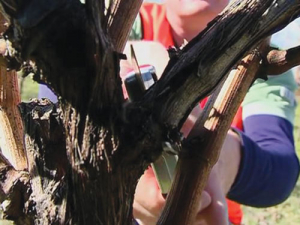After a tough few seasons, with the sexual phase of powdery mildew (Chasmothecia) giving us an extra enemy to consider, and, the loss of some systemic chemicals to control powdery, we have faced an unprecedented work load to keep powdery mildew under control.
Despite the gloom of the past there is good news. We know how to beat it and we know it can be done.
In each edition of the ‘The New Zealand Winegrower Magazine’ for the upcoming season we will keep an eye on powdery mildew and discuss the important things to consider and understand as we move through the season, to help you beat it.
We will look at what science recommends, what to practically do in the vineyard and delve into case studies from around the country as we go.
Posst harvest
Research Sneak Preview
Growers often observe a large increase in powdery mildew symptoms on leaves following harvest. In recent years growers have resorted to post-harvest trimming of infected foliage and additional fungicide sprays. These operations add costs to vineyard management and growers have frequently asked whether reducing autumn inoculum build-up reduces the severity of powdery mildew the following season.
In late summer 2017 NZ Winegrowers conducted a trial in Gisborne where additional powdery mildew fungicides were applied in the lead up to harvest and in the post-harvest period.
These applications reduced leaf infection in May 2017 from 55% to 5% of leaf area infected.
In spring 2017 normal vineyard spray programmes were applied and the level of bunch powdery mildew infection was assessed at veraison.
Despite the differences in autumn leaf infection there was no difference between bunch infection levels at veraison. This result is in line with similar studies conducted overseas. Full results will be published and available soon at www.nzwine.co.nz.
Winter pruning
Control starts with the canopy
Controlling powdery mildew begins at the very start of the season during pruning.
Keeping your canopy open is critical - an open canopy means a less favourable environment for the powdery mildew to establish, and allows sprays to penetrate and achieve better coverage. The chemicals available for powdery control rely on coverage. Any green tissue – fruit or leaf not covered by spray it is not protected from powdery.
During pruning it is important to set up the vines to avoid dense spots developing as the canopy grows.
What to do in the vineyard
Heads - Risk: Too many shoots growing vertically off the head running up through the fruit zone.
What to do:
At pruning leave only enough buds on a VSP head to give you the replacement wood required
Remove as many excess buds as possible by paying attention to making clean secateur cuts.
Do not leave unnecessary spurs
Remove all unwanted head structure with big lopper and saw cuts were possible (don’t forget to protect the wounds)
Cane ends - Risk: Having fruiting cane ends butted right up to or crossing over each other will cause a dense area in the canopy and may result in poor spray coverage.
What to do:
Aim to leave a minimum of a secateurs’ length gap between the laid canes from adjacent vines
Case study: Focusing on canopy management and chemical rates leads to a great powdery season
New Zealand Winegrowers followed 10 vineyards from pre-harvest 2017 to pre-harvest 2018. Each vineyard had powdery mildew levels, vineyard practices assessed, and was provided advice and support on chemical decisions and sprayer setup and technique based on the current recommended best practice for powdery mildew control.
This case study vineyard’s story may be familiar to many. Managing well in general but feeling not quite on top of powdery mildew, with levels slightly higher than they wanted and also feeling the effects of the increased effort and cost that now seem to be required to control powdery.
“Three years ago we were spraying nine rounds and now it seems we have 13 or more just to keep on top”. “As a corporate vineyard we have a threshold of 5% maximum allowable powdery incidence so we have to get it right.”
“The block is Sauvignon Blanc and is pretty dense. We have dense big heads on the vines, and don’t shoot thin. We do leave a hand width gap between canes, and leaf pluck pre 80%, at pre bunch closure and after pre bunch closure”
Over the 2017/18 season the vineyard decided to focus on a few things to try and reduce powdery levels, which have worked really well.
“We started with our pruning, deciding to clear out the bulk from the heads and keep this area more open which made a difference to getting the spray in the canopy. Secondly we tightened up our timing and sprayed for a bit longer. Over the past five years our intervals had gone out so bringing these back has made a major difference. The other big change was with the chemistry. This season we probably threw less chemicals at the vines in general, and we also changed how we calculated the rates so we were more accurate. We adjusted the rates using the Grapelink calculator and ended up applying 3.5 kg/ha of sulphur throughout the season. We also added ‘Actiwett’ to all sulphur application this season to help coverage.”
The efforts of this dedicated team over the season have proven worthwhile as they have had no powdery issues this season, and will not be applying any post-harvest sprays.
Case study
Powdery levels
2016/2017
Bunches: Incidence 26% - Severity 11% - Infection 2.9%
Leaves: Incidence 14% - Severity 1.5% - Infection 0.2%
Powdery levels
2017/2018
Bunches: Incidence 3% - Severity 2.8% - Infection 0.1%
Leaves: Incidence 2% - Severity 1.3% - Infection 0%
For more information on powdery mildew control go to www.nzwine.com
















